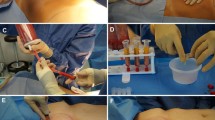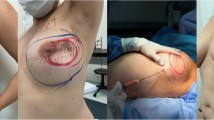Abstract
Background
Although autologous microvascular reconstruction following nipple-sparing mastectomy (NSM) is considered one of the best reconstructive choices, this procedure cannot be offered to all patients. The aim of this study was to define a fat grafting protocol for successful reconstruction following NSM and to assess its reliability in irradiated and non-irradiated patients.
Materials and Methods
Twenty-one patients were prospectively enrolled and stratified in Group-A (11 non-irradiated) and Group-B (10 irradiated) NSMs comparing clinical and aesthetic outcomes. A fat grafting protocol was used to standardize the procedure. Continuous and categorical variables were analysed using the Student t test and the Kruskal–Wallis test, respectively. A value of p ≤ 0.05 was considered statistically significant.
Results
The groups were homogeneous in terms of demographics (p > 0.05), while number of sessions, mean volume of the first two treatments, and overall injected volume showed significant differences (p < 0.001; p < 0.001; p = 0.002). Volume, shape, position of the breast mound, IMF and scar location subscales obtained high score evaluations without a significant difference between the groups (p > 0.05), whereas the skin texture subscale showed a lower score evaluation in Group-B than in Group-A (p = 0.001). Although a significant difference for total subscales was in favour of Group-A (p = 0.001), the global score had a high rate evaluation in both groups (p = 0.132). Inter-rater reliability showed substantial agreement among all categories, total and global scores.
Conclusions
To the best of our knowledge, this is the first prospective series of fat transfer reconstructions following NSM using a systematic approach. Although further studies are required, it may be considered an effective option whenever flap reconstruction cannot be performed.
Level of Evidence III
This journal requires that authors assign a level of evidence to each article. For a full description of these Evidence-Based Medicine ratings, please refer to the Table of Contents or the online Instructions to Authors www.springer.com/00266.




Similar content being viewed by others
References
Didier F, Radice D, Gandini S et al (2009) Does nipple preservation in mastectomy improve satisfaction with cosmetic results, psychological adjustment, body image and sexuality? Breast Cancer Res Treat 118:623–633
Moyer HR, Ghazi B, Daniel JR, Gasgarth R, Carlson GW (2012) Nipple-sparing mastectomy: technical aspects and aesthetic outcomes. Ann Plast Surg 68:446–450
Bodin F, Zink S, Lutz JC et al (2010) Which breast reconstruction procedure provides the best long-term satisfaction? Ann Chir Plast Esthet 55:547–552
Santanelli F, Longo B, Angelini M, Laporta R, Paolini G (2011) Prospective computerized analyses of sensibility in breast reconstruction with non-reinnervated DIEP flap. Plast Reconstr Surg 127:1790–1795
Christensen BO, Overgaard J, Kettner LO et al (2011) Long-term evaluation of postmastectomy breast reconstruction. Acta Oncol 50:1053–1061
Coleman SR, Saboeiro AP (2007) Fat grafting to the breast revisited: safety and efficacy. Plast Reconstr Surg 119:775–785; discussion 786–777
Kling RE, Mehrara BJ, Pusic AL, Young VL, Hume KM, Crotty CA, Rubin JP (2013) Trends in autologous fat grafting to the breast: a national survey of the american society of plastic surgeons. Plast Reconstr Surg 132:35–46
Ross RJ, Shayan R, Mutimer KL, Ashton MW (2013) Autologous fat grafting: current state of the art and critical review. Ann Plast Surg 73:352–357
Santanelli F, Longo B, Germano S, Rubino C, Laporta R, Hamdi M (2014) Total breast reconstruction using the thoracodorsal artery perforator flap without implant. Plast Reconstr Surg 133:251–254
Jouglard JPL (1973) Plasties Mammaires pour Hypertrophie et Ptose. Masson et Cie, Paris
Rigotti G, Marchi A, Khouri RK (2009) Minimally invasive autologous mastectomy incisionless reconstruction; external expansion fat grafting and percutaneous scar release: A multicenter experience. In: Paper Presented at 88th Annual Meeting and Symposium of the American Association of Plastic Surgeons; March 24, 2009; Rancho Mirage, Calif
Garbay JR, Rietjens M, Petit JY (1992) Esthetic results of breast reconstruction after amputation for cancer: 323 cases. J Gynecol Obstet Biol Reprod 21:405–412
Carlson GW, Page AL, Peters K, Ashinoff R, Schaefer T, Losken A (2008) Effects of radiation therapy on pedicled transverse rectus abdominis myocutaneous flap breast reconstruction. Ann Plast Surg 60:568–572
Harris JR, Levene MB, Svensson G et al (1979) Analysis of cosmetic results following primary radiation therapy for stages I and II carcinoma of the breast. Int J Radiat Oncol Biol Phys 5:257–261
Cohen J (1960) A coefficient of agreement for nominal scale. Educat Psychol Meas 20:37–46
Landis JR, Koch GG (1977) The measurement of observer agreement for categorical data. Biometrics 33:159–174
Illouz YG, Sterodimas A (2009) Autologous fat transplantation to the breast: a personal technique with 25 years of experience. Aesthetic Plast Surg 33:706–715
Rigotti G, Marchi A, Stringhini P et al (2010) Determining the oncological risk of autologous lipoaspirate grafting for post-mastectomy breast reconstruction. Aesthetic Plast Surg 34:475–480
Rietjens M, De Lorenzi F, Rossetto F et al (2011) Safety of fat grafting in secondary breast reconstruction after cancer. J Plast Reconstr Aesthet Surg 64:477–483
Petit JY, Lohsiriwat V, Clough KB, Sarfati I, Ihrai T, Rietjens M et al (2011) The oncologic outcome and immediate surgical complications of lipofilling in breast cancer patients: a multicenter study-milan-paris-lyon experience of 646 lipofilling procedures. Plast Reconstr Surg 128:341–346
Petit JY, Rietjens M, Botteri E et al (2013) Evaluation of fat grafting safety in patients with intra epithelial neoplasia: a matched cohort study. Ann Oncol 24:1479–1484
Gosset J, Guerin N, Toussoun G, Delaporte T, Delay E (2008) Radiological evaluation after lipomodelling for correction of breast conservative treatment sequelae (in French). Ann Chir Plast Esthet 53:178–189
Kwak JY, Lee SH, Park HL et al (2004) Sonographic findings in complications of cosmetic breast augmentation with autologous fat obtained by liposuction. J Clin Ultrasound 32:299–301
Cutuli B, Fourquet A, Luporsi E et al (2005) Standards, Options and Recommendations for the management of ductal carcinoma in situ of the breast (DCIS): update 2004. Bull Cancer 92:155–168
Khouri RK, Rigotti G, Cardoso E, Khouri RK Jr, Biggs TM (2014) Megavolume autologous fat transfer: part I. Theory and principles. Plast Reconstr Surg 133:550–557
Khouri RK, Khouri RK Jr, Rigotti G, Marchi A, Cardoso E, Rotemberg SC, Biggs TM (2014) Aesthetic applications of brava-assisted megavolume fat grafting to the breasts: a 9-year, 476-patient, multicenter experience. Plast Reconstr Surg 133:796–807
Del Vecchio DA, Del Vecchio SJ (2014) The graft-to-capacity ratio: volumetric planning in large-volume fat transplantation. Plast Reconstr Surg 133:561–569
Colwell AS, Tessler O, Lin AM et al (2014) Breast reconstruction following nipple-sparing mastectomy: predictors of complications, reconstruction outcomes, and 5-year trends. Plast Reconstr Surg 133:496–506
Uda H, Sugawara Y, Sarukawa S, Sunaga A (2014) Brava and autologous fat grafting for breast reconstruction after cancer surgery. Plast Reconstr Surg 133:203–213
de Baclam C, Momoh AO, Colakoglu S, Tobias AM, Lee BT (2011) Evaluation of clinical outcomes and aesthetic results after autologous fat grafting for contour deformities of the reconstructed breast. Plast Reconstr Surg 128:411e–418e
Longo B, Farcomeni A, Ferri G, Campanale A, Sorotos M, Santanelli F (2013) The BREAST-V: a unifying predictive formula for volume assessment in small, medium, and large breasts. Plast Reconstr Surg 132:1e–7e
Conflict of interest
The authors declare that they have no conflict of interest.
Author information
Authors and Affiliations
Corresponding author
Rights and permissions
About this article
Cite this article
Longo, B., Laporta, R., Sorotos, M. et al. Total Breast Reconstruction Using Autologous Fat Grafting Following Nipple-Sparing Mastectomy in Irradiated and Non-irradiated Patients. Aesth Plast Surg 38, 1101–1108 (2014). https://doi.org/10.1007/s00266-014-0406-3
Received:
Accepted:
Published:
Issue Date:
DOI: https://doi.org/10.1007/s00266-014-0406-3




